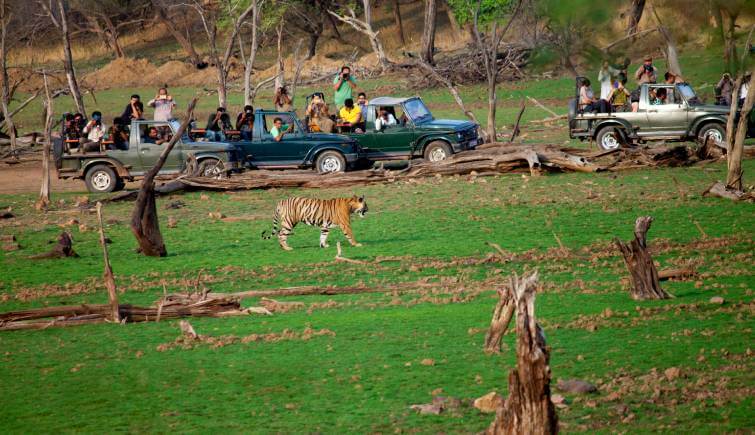Ranthambore National Park, situated in Sawai Madhopur district of Rajasthan is an all-time favourite spot of wildlife enthusiasts in India as well as abroad. The rich biodiversity, the captivating landscapes, the photogenic sceneries and of course the majestic Bengal Tiger definitely make up for an unforgettable experience. But do you know that’s not all the place has to offer? Apart from being a tourist spot, Ranthambore National Park is a success story of environmental conservation. This blog explores how safaris in Ranthambore support conservation efforts, ensuring that both wildlife and local communities benefit.
The Concept of Ecotourism
Ecotourism is a sustainable form of travel that focuses on conserving the environment and improving the well-being of local people. The primary attraction of such travel is the local flora and fauna and appreciation for the cultural heritage. In Ranthambore, you just don’t go to see animals and birds, you will also get to experience the delicate nature between nature and human life.
The Role of Safaris in Conservation
Financial Support for the Park
Safaris bring in money that supports conservation activities like anti-poaching efforts and habitat restoration. Plus, they create jobs for people living nearby, which improves their lives and raises awareness about protecting wildlife.
- Protection against poachers: The forest authorities try their level best to keep endangered species like the Bengal tiger protected from hunters and poachers.
- Maintenance: In order for a diverse set of species to survive, the place requires regular maintenance as well as checks.
- Research and monitoring: The diverse flora and fauna require regular health checkups and the officials ensure they remain in good health.
Employment and Community Involvement
Being a tier 3 city in Rajasthan, Sawai Madhopur had agriculture as the backbone of its economy. But Ranthambore National Park has provided employment to a lot of local people there in the form of rangers, guides, safari drivers, hotel owners and staff etc.
- Economic empowerment: Of course the income earned through tourist activities has helped people support their families financially and led to their economic upliftment.
- Conservation awareness: Since the local community itself is involved in various conservation efforts, this creates a sense of ownership among them as well as a sense of pride.
- Reduced human-wildlife conflict: With their own people involved in conservation practices, they are less likely to involve themselves in activities that destroy the ecosystem like grazing their livestock in open fields etc.
Educational Impact
Visitors on safaris learn a lot from guides about the park’s plants and animals. The guides tell them how the animals, birds and plants are taken care of in the national park. They also tell them how such efforts benefit the entire ecosystem. This knowledge inspires them to act as ambassadors of conservation back home.
Sustainable Practices
Ranthambore National Park has implemented several sustainable practices to minimize the environmental impact of tourism. These include:
- Controlled Tourism: Do you know there is a limit to the number of vehicles that could be running at a time inside the national park? This is to control air as well as noise pollution and also so that the animals are not too disturbed by external interference.
- Eco-friendly Infrastructure: Nothing destroys a place more than wrongly disposed waste. That’s why there is an eco-friendly waste management system at Ranthambore.
- Community-Based Initiatives: No place can be called preserved unless its people are taken care of too. That why the local people as well as businesses are supported by the forest officials and make sure the rewards reach them too.
The Tiger Watch Program
The forest department launched a program for preserving as well as increasing the population of tigers in the area. It’s called the Tiger Watch Program which has been a big success over the years. Not only have they been able to preserve the numbers, they have, in fact, increased them. It involves regular monitoring of tigers’ health, research to keep them healthier, protection from poachers etc.
Personal Reflections from Visitors
Many visitors to Ranthambore leave with a deeper appreciation for wildlife and a greater understanding of the importance of conservation. Here are a few reflections:
“We booked our trip to Ranthambore through Rajasthan Ranthambore Safari. The knowledge shared by our guide during our safari was definitely the highlight of my trip. Being a traveller, I never even realised what I could contribute to the places I visit just by taking some small steps. I am definitely impressed by it and gonna educate more people so that we can preserve such places.” – Sarah M., Traveler
“I definitely was in awe after seeing not one but three tigers on my visit to Ranthambore. I am definitely gonna tell stories about it wherever I go. But what I also won’t miss is how the system is perfectly built here, everything contributes towards maintenance and conservation of this heavenly place.” – John D., Photographer
Conclusion
Ranthambore, thus, turns out as a shining example of how eco-tourism can pave the way for a sustainable and conserved environment. After witnessing the brilliant conservation efforts at Ranthambore, people not only leave with just some insta-worthy pictures but also deep-seated respect for nature and the significance of its conservation. It, therefore, becomes every traveller’s responsibility to make sure his visit doesn’t spoil the place so that such natural spots can thrive for generations to come.
